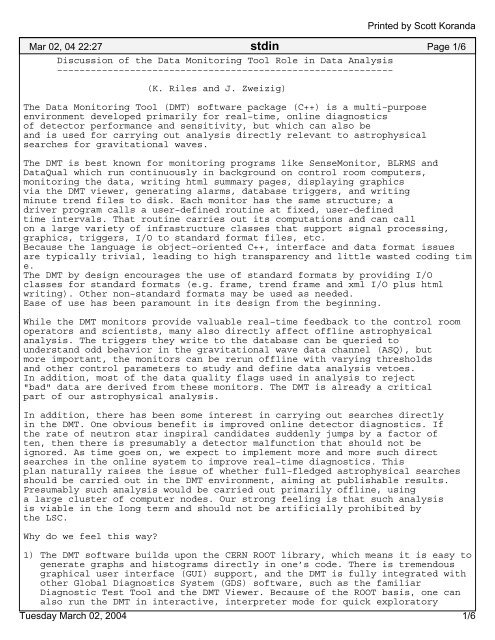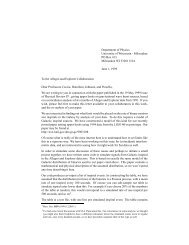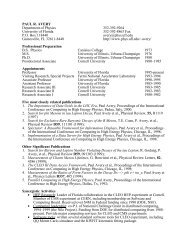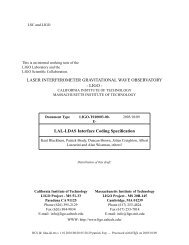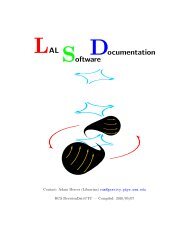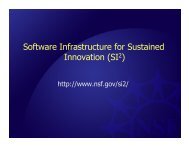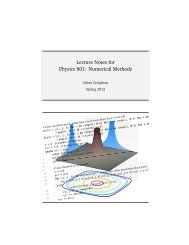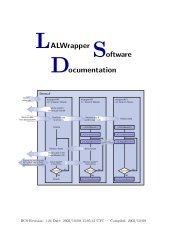stdin - UWM LSC
stdin - UWM LSC
stdin - UWM LSC
Create successful ePaper yourself
Turn your PDF publications into a flip-book with our unique Google optimized e-Paper software.
Mar 02, 04 22:27 Page 1/6<br />
Discussion of the Data Monitoring Tool Role in Data Analysis<br />
−−−−−−−−−−−−−−−−−−−−−−−−−−−−−−−−−−−−−−−−−−−−−−−−−−−−−−−−−−−−<br />
(K. Riles and J. Zweizig)<br />
The Data Monitoring Tool (DMT) software package (C++) is a multi−purpose<br />
environment developed primarily for real−time, online diagnostics<br />
of detector performance and sensitivity, but which can also be<br />
and is used for carrying out analysis directly relevant to astrophysical<br />
searches for gravitational waves.<br />
The DMT is best known for monitoring programs like SenseMonitor, BLRMS and<br />
DataQual which run continuously in background on control room computers,<br />
monitoring the data, writing html summary pages, displaying graphics<br />
via the DMT viewer, generating alarms, database triggers, and writing<br />
minute trend files to disk. Each monitor has the same structure; a<br />
driver program calls a user−defined routine at fixed, user−defined<br />
time intervals. That routine carries out its computations and can call<br />
on a large variety of infrastructure classes that support signal processing,<br />
graphics, triggers, I/O to standard format files, etc.<br />
Because the language is object−oriented C++, interface and data format issues<br />
are typically trivial, leading to high transparency and little wasted coding tim<br />
e.<br />
The DMT by design encourages the use of standard formats by providing I/O<br />
classes for standard formats (e.g. frame, trend frame and xml I/O plus html<br />
writing). Other non−standard formats may be used as needed.<br />
Ease of use has been paramount in its design from the beginning.<br />
While the DMT monitors provide valuable real−time feedback to the control room<br />
operators and scientists, many also directly affect offline astrophysical<br />
analysis. The triggers they write to the database can be queried to<br />
understand odd behavior in the gravitational wave data channel (ASQ), but<br />
more important, the monitors can be rerun offline with varying thresholds<br />
and other control parameters to study and define data analysis vetoes.<br />
In addition, most of the data quality flags used in analysis to reject<br />
"bad" data are derived from these monitors. The DMT is already a critical<br />
part of our astrophysical analysis.<br />
In addition, there has been some interest in carrying out searches directly<br />
in the DMT. One obvious benefit is improved online detector diagnostics. If<br />
the rate of neutron star inspiral candidates suddenly jumps by a factor of<br />
ten, then there is presumably a detector malfunction that should not be<br />
ignored. As time goes on, we expect to implement more and more such direct<br />
searches in the online system to improve real−time diagnostics. This<br />
plan naturally raises the issue of whether full−fledged astrophysical searches<br />
should be carried out in the DMT environment, aiming at publishable results.<br />
Presumably such analysis would be carried out primarily offline, using<br />
a large cluster of computer nodes. Our strong feeling is that such analysis<br />
is viable in the long term and should not be artificially prohibited by<br />
the <strong>LSC</strong>.<br />
Why do we feel this way?<br />
<strong>stdin</strong><br />
Printed by Scott Koranda<br />
1) The DMT software builds upon the CERN ROOT library, which means it is easy to<br />
generate graphs and histograms directly in one’s code. There is tremendous<br />
graphical user interface (GUI) support, and the DMT is fully integrated with<br />
other Global Diagnostics System (GDS) software, such as the familiar<br />
Diagnostic Test Tool and the DMT Viewer. Because of the ROOT basis, one can<br />
also run the DMT in interactive, interpreter mode for quick exploratory<br />
Tuesday March 02, 2004 1/6
<strong>stdin</strong><br />
Printed by Scott Koranda<br />
Mar 02, 04 22:27 Page 2/6<br />
studies.<br />
2) Given the distributed nature of <strong>LSC</strong> analysis and the desire for common tools,<br />
+<br />
an object−oriented language, and C++ in particular, has strong advantages. C+<br />
is strongly typed and makes well defined interfaces the norm rather than an<br />
ideal that is attained only with difficulty. The encapsulation of data and<br />
methods also makes debugging and verification much easier. The programmer can<br />
devote a larger fraction of time to algorithm development and spend less time<br />
worrying about the "protocol" of the programming language and the details of<br />
how a routine written by another author stores and manipulates data.<br />
At the start of DMT development, we were concerned that potential<br />
contributers would resist a change to C++. We therefore made a parallel<br />
C language development path available for these users. In fact we found<br />
that our contributers overwhelmingly chose to use the more extensive<br />
capabilities available through C++.<br />
3) Because the C language is a subset of C++, one may link directly to C<br />
libraries, such as the <strong>LSC</strong> Analysis Library (LAL) and use desired routines,<br />
as needed. It seems highly likely that as we develop online astrophysical<br />
search programs for detector diagnostics, some of the routines already<br />
present in LAL will be exploited. Working in the DMT in no way precludes<br />
using routines in LAL, and if sufficient demand arises, LAL "wrappers"<br />
can be written to make LAL routines more friendly to DMT users.<br />
h<br />
There was discussion some years ago of "bundling" DMT and LAL together, but<br />
that idea was rejected since the online DMT code is mission critical, and a<br />
sudden failure of DMT compilation because of changes in LAL was considered<br />
unacceptable. But the lack of deliberate bundling into a common software<br />
framework does not prevent individual analysts from creating stand−alone<br />
DMT programs that use LAL infrastructure, just as they might call a routine<br />
from CLAPACK. This is already standard practice; for example, USGS seismograp<br />
code (written in C) was imported for use in the PTmon DMT monitor.<br />
4) The DMT infrastructure and its monitoring programs have been subjected to<br />
rigorous high−level performance evaluation from the start. The low−level<br />
code has been tested and is literally in constant use (~40 monitor processes<br />
have been running online for several years). Some of the code (e.g. the filte<br />
r<br />
design classes) are vital for the operation of the LIGO interferometers, and<br />
many other pieces of the DMT code are used daily for IFO commissioning and<br />
operations.<br />
While there has been less emphasis on formal validation of the monitor progra<br />
m<br />
functionality than in some other <strong>LSC</strong> software for which realistic test vector<br />
s<br />
can be supplied, we believe the DMT codes have had considerable and more<br />
demanding vetting of performance evaluation on real, non−stationary,<br />
non−Gaussian inteferometer data. For example, because the online DMT monitors<br />
must routinely process data in high−noise states and even when the interferom<br />
eter<br />
is unlocked, standard tools have been developed to determine interferometer s<br />
tate<br />
and exclude poor data "on the fly".<br />
2/6 Tuesday March 02, 2004
Printed by Scott Koranda<br />
Mar 02, 04 22:27 <strong>stdin</strong><br />
Page 3/6<br />
n<br />
Nonetheless, there is obvious virtue in low−level vetting of routines using<br />
artificially generated data. One may catch bugs that affect only small<br />
fractions of the data or appear as normalization errors and hence may have<br />
escaped notice, despite the high−level vetting in engineering and science<br />
data runs. Until recently, monitor authors and detector characterizers have<br />
had to evaluate the performance of a monitor based on its response to live<br />
(i.e. uncharacterized) data. A new set of simulation and evaluation tools<br />
exists now, however, that allows rapid and quantitative performance evaluatio<br />
of monitors as function of their own control parameters. Histograms and<br />
efficiency curves are now easy to produce in standardized form. We believe<br />
these tools will allow the finding of residual bugs in existing monitors and,<br />
more important, allow those monitors to be better tuned for performance.<br />
It should be pointed out that debugging and validation/verification are<br />
greatly helped in the DMT environment by<br />
* Interactive development and testing "in the same language"<br />
* Support of histogramming and direct data visualization, vital to effective<br />
code development<br />
* Standardized low−level classes common to many monitoring programs<br />
* The use of base classes provides stable, uniform and well defined interface<br />
s<br />
to shared code and makes rewriting or copying of basic code unnecessary.<br />
Other issues:<br />
1) The DMT and other GDS code is stored in CVS archives with periodic tags given<br />
to new releases, particularly those associated with engineering and science<br />
data runs.<br />
2) The documentation of DMT infrastructure and monitors is uneven. There is ampl<br />
e<br />
infrastructure for documention via doc++, automated links for online monitors<br />
,<br />
automated links for online alarms, an online troubleshooting guide, some web<br />
overview material, and a DMT home page with descriptions of code infrastructu<br />
re<br />
and templates. Unfortunately, not all DMT monitor authors have provided<br />
adequate (or any!) documentation. In addition, one sorely missing document is<br />
a "Getting Started" manual for first−time monitor writers, one that would<br />
provide a standard template. As it is, most authors simply copy an existing<br />
monitor program and modify it for their needs.<br />
3) The DMT and other GDS code was initially developed under Solaris, but is<br />
available and has been tested on linux. Various users have had varying<br />
success in porting to linux because of library/compiler compatibility<br />
issues. More work is needed before it can be claimed that the DMT is truly<br />
portable. See below under "ITR Grant".<br />
4) Online access of data via the DMT is extremely straightforward. One merely<br />
starts the program and the data streams into the monitor via the local shared<br />
memory partition. Offline data access uses the same mechanism, but reads<br />
data from a list of frame files rather than the shared memory. However,<br />
because the infrastructure for running DMT jobs on a cluster has not been<br />
developed yet, the process of dividing the task among several processes,<br />
Tuesday March 02, 2004 3/6
Mar 02, 04 22:27 Page 4/6<br />
locating input data, verifying that a process has run, and collating the<br />
results can be cumbersome. This is being addressed as described below under<br />
"ITR Grant".<br />
5) Bug reporting for the DMT infrastructure and monitors is handled via GNATS:<br />
https://ldas−sw.ligo.caltech.edu/cgi−bin/gnatsweb.cgi?database=gds<br />
There is an e−mail distribution list for discussion of DMT issues:<br />
https://tenaya.physics.lsa.umich.edu/mailman/listinfo/dmt−discuss<br />
ITR Grant:<br />
Recently the National Science Foundation (NSF) awarded a consortium of <strong>LSC</strong><br />
institutes (PI: Eric Katsavounidis of MIT) an Information Technology Research<br />
(ITR) grant to support advanced <strong>LSC</strong> data analysis work using GRID technologies.<br />
Part of that grant is dedicated to DMT support, with DMT FTE’s allocated to Penn<br />
State, MIT, and <strong>UWM</strong>. MIT has just hired a programmer / physicist to spend part<br />
time on "gridifying" the DMT, to allow for much better transparency in data<br />
access and efficient remote submission and control of jobs. Penn State has an<br />
advertisement out for a programmer / physicist to work part time on improved<br />
porting of the DMT to unix and linux platforms. It is envisioned that once this<br />
work is complete, Penn State would provide a server for automated nightly update<br />
s<br />
of DMT code via RPM’s, making the DMT more widely available in the collaboration<br />
with better uniformity.<br />
In addition, we are requesting from LIGO Laboratory the use of Beowulf cluster<br />
nodes at the observatory sites for running DMT jobs offline on archived data.<br />
We have in mind that with the "gridification" of the DMT, these jobs would be<br />
treated on the same footing as LAL−based jobs and would not add appreciably to<br />
the load on site personnel already managing the clusters.<br />
Summary:<br />
<strong>stdin</strong><br />
Printed by Scott Koranda<br />
The DMT has proven to be an extremely useful software environment for online<br />
detector diagnostics and offline detector characterization affecting<br />
astrophysical data analysis. We believe it has considerable promise for an<br />
expanded role in astrophysical data analysis, thanks to its object−oriented<br />
structure, ease of use, and substantial graphical and histogramming support.<br />
It is the <strong>LSC</strong> software package that most resembles the successful analysis<br />
environments of large high energy physics experiments.<br />
It is not that we advocate analysts now happily using LAL should adopt the DMT<br />
instead. As discussed above, there are still technical impediments to<br />
seamless offline analysis of months of data, and the installation of the DMT<br />
on non−Solaris platforms can take more time than it should. We expect that<br />
these impediments will be removed by the end of 2004. We do suggest, though,<br />
that analysts take a closer look at the DMT. Working in LAL for data<br />
manipulation and in Matlab for visualization is not necessarily a better<br />
choice than using one software package that supports both of those functions<br />
and that can be used both online and offline. Moreover, the ability to link<br />
directly to the LAL library means one need not sacrifice any existing analysis<br />
functionality.<br />
Finally, this memo has been provoked not by a sudden desire to proselytize LAL<br />
4/6 Tuesday March 02, 2004
Mar 02, 04 22:27 Page 5/6<br />
users into converting to the DMT way, but rather by what we consider a badly<br />
misguided recommendation by an ad hoc committeee that the DMT be prohibited from<br />
use in astrophysics analysis. To those of us familiar with the DMT and the<br />
real−world vetting it has been subjected to, it seems foolish to preclude its<br />
use in astrophysical analysis, merely to ensure uniformity of tools within the<br />
collaboration. Experience has shown, we believe, that "market forces" should<br />
prevail. A software environment that is more trouble to use than it’s worth will<br />
fade into disuse, and environments that prove useful will grow in use. There<br />
need not be only one such useful environment the <strong>LSC</strong>. We have already seen<br />
the perils of prematurely adopting a software environment as the one and only<br />
standard. Let us not repeat past mistakes.<br />
Appendix:<br />
The DASWG requested specific information on four issues. Although much of<br />
that information is contained in the above, we address these issues<br />
explicitly below and provide additional web pointers.<br />
1) Accessibility/cost of DMT/GEO++ to entire collaboration.<br />
The DMT belongs to the <strong>LSC</strong> and is freely available for cvs downloads. It<br />
uses the CERN ROOT library, which is also freely available.<br />
For more information on the DMT, please see<br />
http://www.ligo.caltech.edu/~jzweizig/dmt/DMTProject/<br />
For more information on ROOT, please see<br />
http://root.cern.ch/<br />
<strong>stdin</strong><br />
2) Platform and other support of DMT/GEO++.<br />
As discussed above, DMT is actively supported on Solaris and linux. DMT<br />
code has been installed and tested on both platforms and any problems<br />
found on either platform are addressed quickly by the authors. The linux<br />
support lags that for Solaris because of the demands of online use, but<br />
this situation should improve as work for the ITR grant ramps up.<br />
3) Possibility to hook libraries (e.g. LAL, etc) into<br />
DMT/GEO++ to leverage other existing code bases.<br />
Printed by Scott Koranda<br />
As discussed above, we know of no reason an individual DMT program cannot<br />
link to LAL and use any desired routines. Other C libraries have been linked<br />
successfully<br />
to DMT programs. There is good reason, however, not to bundle DMT and LAL<br />
together unless individual LAL interfaces are stablized and the release<br />
schedule for LAL is coordinated with DMT.<br />
4) How version control, documentation and validation should be handled.<br />
* The DMT is under CVS control. There have been a number of tagged releases<br />
over<br />
the last several years, usually associated with science and engineering ru<br />
ns.<br />
* Documentation of the infrastructure and individual monitors is handled at<br />
Tuesday March 02, 2004 5/6
<strong>stdin</strong><br />
Mar 02, 04 22:27 Page 6/6<br />
the<br />
coding level by doc++. In addition, there are separate documents (pdf and/<br />
or html)<br />
describing the infrastructure and monitors, but as discussed above, the de<br />
gree and quality<br />
of documentation varies widely among the online monitors.<br />
Overview documentation of the DMT can be found at<br />
http://www.ligo.caltech.edu/~jzweizig/dmt/DMTProject/<br />
Documentation of online monitors can be found at<br />
http://blue.ligo−wa.caltech.edu/gds/dmt/Monitors/MonTable.html<br />
Printed by Scott Koranda<br />
* As discussed above, validation of online DMT monitors has been extensive a<br />
t a high<br />
level because of the demanding nature of data runs. Much of the low level<br />
code common<br />
to many monitors has been validated to the extent that many monitors have<br />
been using<br />
the common code for many years. Some of the filtering code is also used di<br />
rectly in<br />
the interferometer controls.<br />
Nonetheless, more validation would be desirable. A new set of simulation a<br />
nd<br />
evaluation tools exists now that should facilitate systematic validation a<br />
nd<br />
performance evaluation. Information on these tools and example outputs can<br />
be found at<br />
html<br />
http://www.ligo.caltech.edu/~jzweizig/dmt/DMTProject/DMT−DataSimulation.<br />
http://www.ligo.caltech.edu/~jzweizig/dmt/DMTProject/MatchTrig1.pdf<br />
It should be pointed out that debugging and validation/verification are<br />
greatly helped in the DMT environment by<br />
* Interactive development and testing "in the same language"<br />
* Support of histogramming and direct data visualization, vital to effecti<br />
ve code development<br />
* Comprehensive independent class libraries for I/O, Data manipulation,<br />
Signal processing, etc. available to all monitoring programs.<br />
* The use of base classes provides stable, uniform and well defined interf<br />
aces<br />
to shared code and makes rewriting or copying of basic code unnecessary.<br />
6/6 Tuesday March 02, 2004


